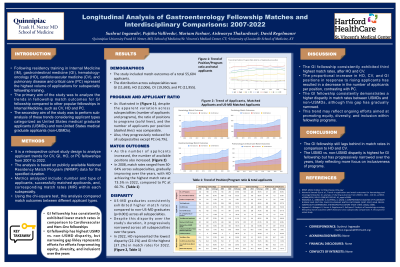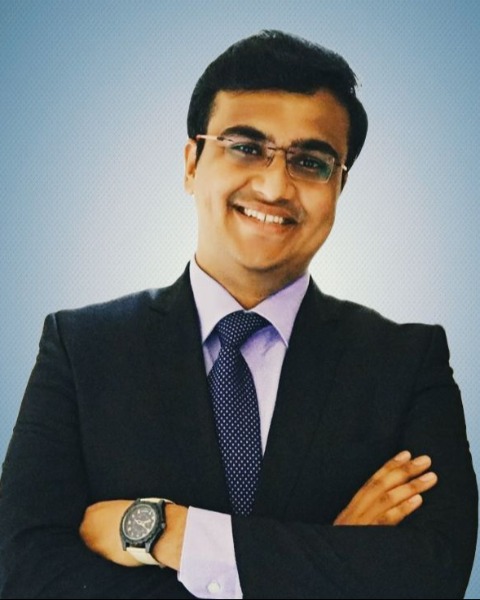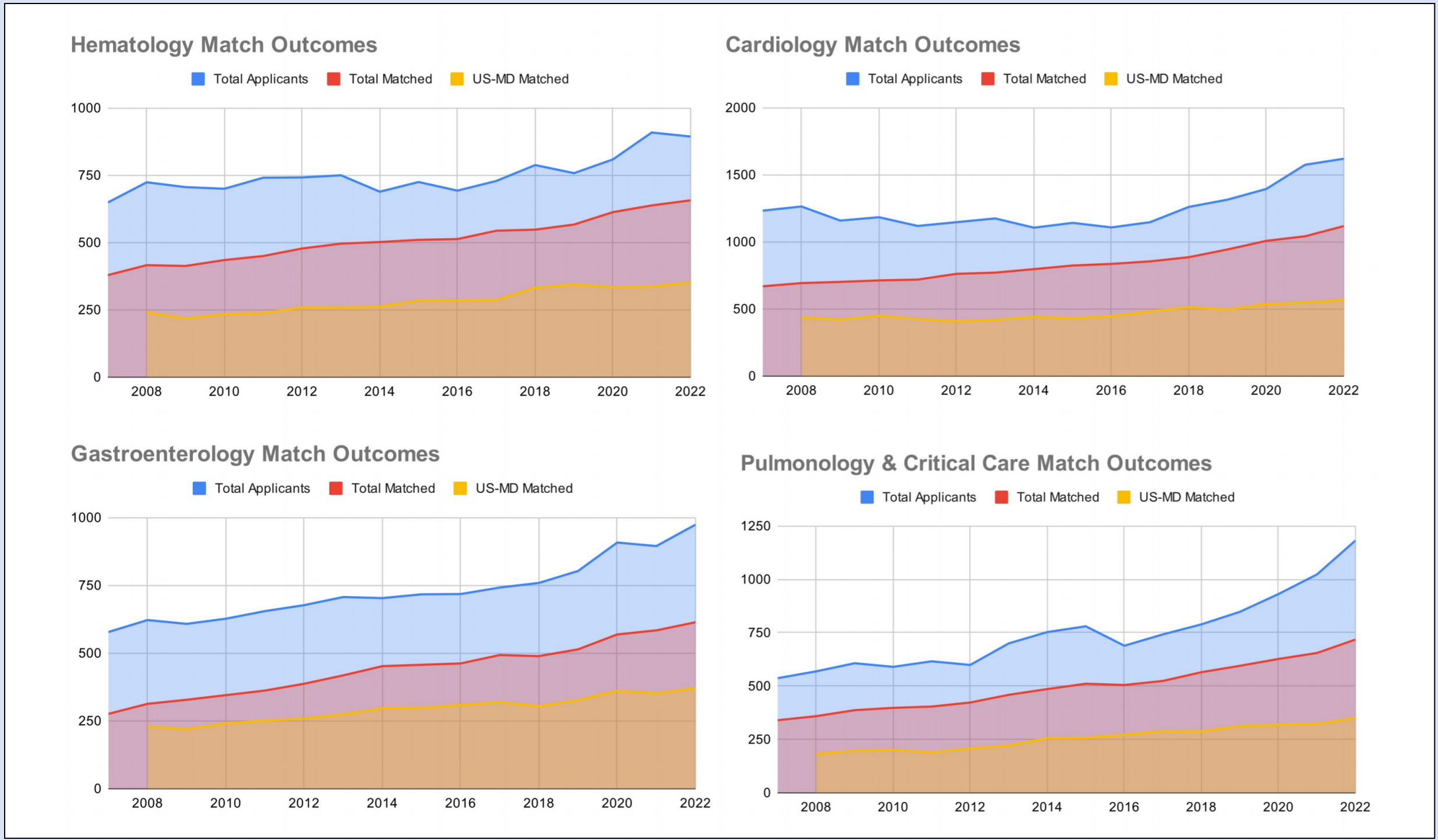Sunday Poster Session
Category: Practice Management
P1513 - Longitudinal Analysis of Gastroenterology Fellowship Matches and Interdisciplinary Comparisons: 2007-2022
Sunday, October 27, 2024
3:30 PM - 7:00 PM ET
Location: Exhibit Hall E

Has Audio

Sushrut Ingawale, MD, MBBS
Quinnipiac University Frank H. Netter MD School of Medicine / St. Vincent's Medical Center
Bridgeport, CT
Presenting Author(s)
Sushrut Ingawale, MD, MBBS1, Pujitha Vallivedu Chennakesavulu, MD, MBBS1, Aishwarya Thakurdesai, MBBS2, Mariam Farhan, MD1, David Regelmann, MD1
1Quinnipiac University Frank H. Netter MD School of Medicine / St. Vincent's Medical Center, Bridgeport, CT; 2University of Louisville School of Medicine, Louisville, KY
Introduction: The analysis focuses on trends in fellowship match outcomes for Hematology-Oncology (HO) compared to other popular fellowships in Internal Medicine, such as Cardiovascular (CV), Gastroenterology (GI), and Pulmonology-Critical Care (PC). It specifically examines subset outcomes within the National Residency Match Program, considering applicant types categorized as United States medical graduate applicants (USMDs) and non-United States medical graduate applicants (non-USMDs).
Methods: This retrospective cohort study analyzes applicants who applied to CV, GI, HO, or PC fellowships for 2007-2022. The analysis is based on publicly available NRMP data for this time. Metrics analyzed include: number and type of applicants, successfully matched applicants, and, corresponding match rates (MR) within each subspecialty. Using the chi-square test, this analysis compared match outcomes between different applicant types.
Results: Out of total 55,604 applicants, the distribution across subspecialties was as follows: CV (19,950), GI (11,693), HO (12,006), and PC (11,955). Despite variations in the number of applicants and programs among subspecialties, the ratio of positions to programs and the number of applicants per position were comparable. The number of applicants per position decreased progressively from 2007 to 2022 for all subspecialties except PC, which saw a 6.7% increase. As the number of applicants increased, the number of available positions also increased significantly. Match rates (MR) ranged from 50-64% across subspecialties in 2008, gradually increasing over the years [Figure]. By 2022, HO had the highest MR at 73.5%, compared to PC at 60.7%. USMDs consistently had higher MRs compared to non-USMDs across all subspecialties (p< 0.001). Despite this persistent gap over the study period, the difference narrowed progressively across all subspecialties by 2022. HO showed the smallest difference at 22.1%, while GI had the largest at 37.2% in match rates for that year.
Discussion: The GI fellowship exhibited third highest match rates, after HO and CV. The proportional increase in HO, CV, and GI positions in response to rising applicants has resulted in a decrease in the number of applicants per position, contrasting with PC. The GI fellowship consistently demonstrates a higher disparity in match rates between USMDs and non-USMDs, although this gap has gradually narrowed. This trend may reflect ongoing efforts aimed at promoting equity, diversity, and inclusion within fellowship programs.

Note: The table for this abstract can be viewed in the ePoster Gallery section of the ACG 2024 ePoster Site or in The American Journal of Gastroenterology's abstract supplement issue, both of which will be available starting October 27, 2024.
Disclosures:
Sushrut Ingawale, MD, MBBS1, Pujitha Vallivedu Chennakesavulu, MD, MBBS1, Aishwarya Thakurdesai, MBBS2, Mariam Farhan, MD1, David Regelmann, MD1. P1513 - Longitudinal Analysis of Gastroenterology Fellowship Matches and Interdisciplinary Comparisons: 2007-2022, ACG 2024 Annual Scientific Meeting Abstracts. Philadelphia, PA: American College of Gastroenterology.
1Quinnipiac University Frank H. Netter MD School of Medicine / St. Vincent's Medical Center, Bridgeport, CT; 2University of Louisville School of Medicine, Louisville, KY
Introduction: The analysis focuses on trends in fellowship match outcomes for Hematology-Oncology (HO) compared to other popular fellowships in Internal Medicine, such as Cardiovascular (CV), Gastroenterology (GI), and Pulmonology-Critical Care (PC). It specifically examines subset outcomes within the National Residency Match Program, considering applicant types categorized as United States medical graduate applicants (USMDs) and non-United States medical graduate applicants (non-USMDs).
Methods: This retrospective cohort study analyzes applicants who applied to CV, GI, HO, or PC fellowships for 2007-2022. The analysis is based on publicly available NRMP data for this time. Metrics analyzed include: number and type of applicants, successfully matched applicants, and, corresponding match rates (MR) within each subspecialty. Using the chi-square test, this analysis compared match outcomes between different applicant types.
Results: Out of total 55,604 applicants, the distribution across subspecialties was as follows: CV (19,950), GI (11,693), HO (12,006), and PC (11,955). Despite variations in the number of applicants and programs among subspecialties, the ratio of positions to programs and the number of applicants per position were comparable. The number of applicants per position decreased progressively from 2007 to 2022 for all subspecialties except PC, which saw a 6.7% increase. As the number of applicants increased, the number of available positions also increased significantly. Match rates (MR) ranged from 50-64% across subspecialties in 2008, gradually increasing over the years [Figure]. By 2022, HO had the highest MR at 73.5%, compared to PC at 60.7%. USMDs consistently had higher MRs compared to non-USMDs across all subspecialties (p< 0.001). Despite this persistent gap over the study period, the difference narrowed progressively across all subspecialties by 2022. HO showed the smallest difference at 22.1%, while GI had the largest at 37.2% in match rates for that year.
Discussion: The GI fellowship exhibited third highest match rates, after HO and CV. The proportional increase in HO, CV, and GI positions in response to rising applicants has resulted in a decrease in the number of applicants per position, contrasting with PC. The GI fellowship consistently demonstrates a higher disparity in match rates between USMDs and non-USMDs, although this gap has gradually narrowed. This trend may reflect ongoing efforts aimed at promoting equity, diversity, and inclusion within fellowship programs.

Figure: Figure: Graphical Representation of Trend of Match Outcomes for Four Most Sought-after Fellowships following Internal Medicine: Cardiovascular (CV), Gastroenterology (GI), Hematology-Oncology (HO), and Pulmonology-Critical Care (PC)
Footnotes: (1) X-axis represents the Year, and, Y-axis represents the number of applicants; (2) Blue represents Total Applicants, Red represents Total Matched Applicants, Yellow represents Total Matched United States medical graduate applicants (USMDs), the Gap between Blue and Red Lines represents Total Unmatched Applicants, and, the Gap between Blue and Yellow Lines represents Total Matched non-United States medical graduate applicants (non-USMDs). (3) No data available for Year 2007 for Total Matched United States medical graduate applicants (USMDs).
Footnotes: (1) X-axis represents the Year, and, Y-axis represents the number of applicants; (2) Blue represents Total Applicants, Red represents Total Matched Applicants, Yellow represents Total Matched United States medical graduate applicants (USMDs), the Gap between Blue and Red Lines represents Total Unmatched Applicants, and, the Gap between Blue and Yellow Lines represents Total Matched non-United States medical graduate applicants (non-USMDs). (3) No data available for Year 2007 for Total Matched United States medical graduate applicants (USMDs).
Note: The table for this abstract can be viewed in the ePoster Gallery section of the ACG 2024 ePoster Site or in The American Journal of Gastroenterology's abstract supplement issue, both of which will be available starting October 27, 2024.
Disclosures:
Sushrut Ingawale indicated no relevant financial relationships.
Pujitha Vallivedu Chennakesavulu indicated no relevant financial relationships.
Aishwarya Thakurdesai indicated no relevant financial relationships.
Mariam Farhan indicated no relevant financial relationships.
David Regelmann indicated no relevant financial relationships.
Sushrut Ingawale, MD, MBBS1, Pujitha Vallivedu Chennakesavulu, MD, MBBS1, Aishwarya Thakurdesai, MBBS2, Mariam Farhan, MD1, David Regelmann, MD1. P1513 - Longitudinal Analysis of Gastroenterology Fellowship Matches and Interdisciplinary Comparisons: 2007-2022, ACG 2024 Annual Scientific Meeting Abstracts. Philadelphia, PA: American College of Gastroenterology.
